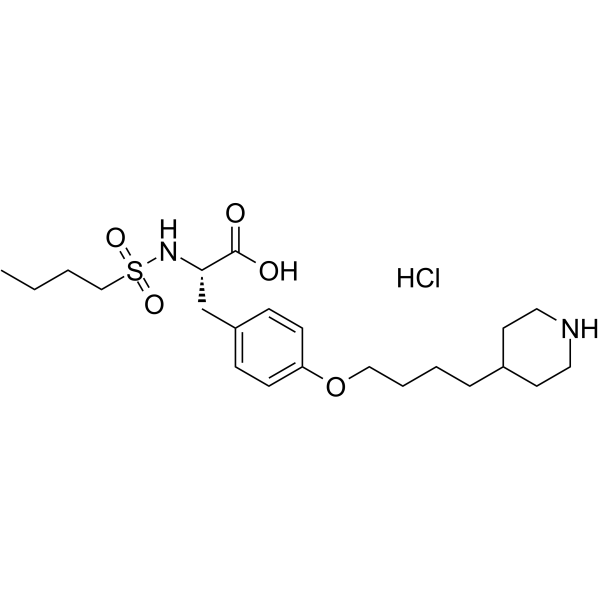142373-60-2
| Name | tirofiban hydrochloride monohydrate |
|---|---|
| Synonyms |
Tirofibanhydrochloride
N-(butylsulfonyl)- O-[4-(4-piperidinyl)butyl]-L-tyrosine monohydrochloride monohydrate N-(Butylsulfonyl)-O-[4-(4-piperidinyl)butyl]tyrosine hydrochloride hydrate N-(Butylsulfonyl)-O-[4-(piperidin-4-yl)butyl]-L-tyrosine hydrochloride hydrate Tirofiban hydrochloride tirofiban hydrochloride anhydrous Tyrosine, N-(butylsulfonyl)-O-[4-(4-piperidinyl)butyl]-, hydrochloride, hydrate (1:1:1) |
| Description | Tirofiban (L700462) hydrochloride is a Gp IIb/IIIa receptor antagonist of nonpeptide derivative of tyrosine. Tirofiban hydrochloride induces proliferation and migration on endothelial cell by inducing production of VEGF. Tirofiban hydrochloride can significantly reduces myocardial no-reflow and ischemia-reperfusion injury by alleviating myocardial microvascular structural and endothelial dysfunction in the ischemic area[1][2]. |
|---|---|
| Related Catalog | |
| Target |
Gp IIb/IIIa receptor[1]. |
| In Vitro | Tirofiban hydrochloride (0.25, 1, 3 μg/mL; 72 hours) increases proliferation of HAEC cells[1]. Tirofiban hydrochloride (24 hours) closes the scratch of HUVECs migration within 18 hours[1]. Tirofiban hydrochloride (0.25, 1 μg/mL; 1 hour) induces production of VEGF after 30 minutes which can stimulates proliferation of endothelial cells[1]. Cell Proliferation Assay[1] Cell Line: HAEC Concentration: 0.25, 1, 3 μg/mL Incubation Time: 72 hours Result: Increased proliferation of HAEC cells. Cell Migration Assay [1] Cell Line: HUVEC Concentration: Incubation Time: 24 hours Result: Stimulated the migratory capacity of endothelial cells. Western Blot Analysis[1] Cell Line: HAEC Concentration: 0.05, 0.12, 0.25, 1 μg/mL Incubation Time: 1 hour Result: Induced production of VEGF which stimulated proliferation of endothelial cells. |
| In Vivo | Tirofiban hydrochloride (60 μg/kg; i.v.; once) shows activity of increasing contraction force, ventricular compliance, and improving heart function by increasing HR, LVESP, dp/dtmax, and reducing LVEDP[2]. Tirofiban hydrochloride (60 μg/kg; i.v.; once) enhances eNOS activity, decreases iNOS activity and reduces area of no-reflow after reperfusion following AMI[2]. Animal Model: Male Sprague-Dawley rats (10 to 15-week-age; 270-330 g)[2]. Dosage: 60 μg/kg Administration: Intravenous injection; once Result: Increased contraction force, ventricular compliance, and improved heart function.< br/>Reduced the size of no-reflow and infarct. |
| References |
| Boiling Point | 611.7ºC at 760mmHg |
|---|---|
| Melting Point | 223-225ºC |
| Molecular Formula | C22H39ClN2O6S |
| Molecular Weight | 495.073 |
| Flash Point | 323.7ºC |
| Exact Mass | 494.221741 |
| PSA | 122.34000 |
| LogP | 5.48870 |
| Vapour Pressure | 8.09E-16mmHg at 25°C |
